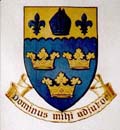|
This text, courtesy of Mike Skivington.
St Mary's College had been established as a diocesan school at Woolhampton
in 1833 with 3 students. In 1838 it became a boarding school which by 1840
had 20 boys. By 1855 this had risen to 129 but numbers had fallen to only
60 by 1903. After the two schools joined the numbers rose to 107. Some
of the buildings familiar to later generations were already in place enclosing
three sides of a quadrangle. What later became known as the school chapel
and is now known as St Mary's had been built in 1848 and the Haydock wing
(including the study hall and school tower) had been erected in 1860.
Initially the accommodation was very crowded with boys and monks living in close proximity. There was an urgent need to expand the buildings and separate monastery and school. The foundation stone of the monastery building, known as the "Ark" was laid in 1914 and the monks moved in during 1916. The school refectory and brown dormitory were built at about the same time. Just prior to the second world war the school buildings were further enlarged by the addition of the senior wing which included the Bede library and the theatre/ gymnasium block and swimming pool. The Beenham path, later rerouted behind the pool separated the senior wing from the theatre.
The "temporary" science laboratories were erected in1950 and
following the closure of the junior school at Ditcham Park, Ditcham house
was completed in 1980
Initially the senior masters retained their titles of prefect of discipline and prefect of studies, the term "Headmaster" not coming in to general use until about the time of the first world war. Fr Ignatius Rice began his long reign as headmaster in 1915 and in 1920 Douai joined the Headmasters' Conference schools . Houses were not introduced until the early 1950s
|
